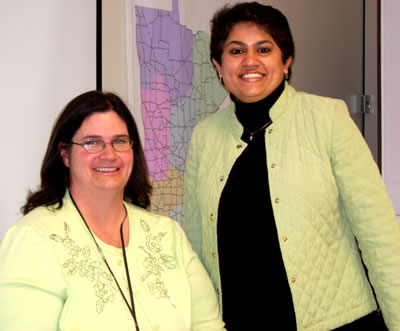|
By Lucy Kender, Human Resources

Mary Stohr, Metro District Human Resources director, and Emma Corrie, Mn/DOT recruitment programs supervisor, hope that the diversity-focused recruitment and hiring momentum gained in the recent transportation associate mass hiring at Metro District continues in the future. Photo by Lisa Yang |
Collaboration, creativity and community connections played critical roles in the recent mass hiring of transportation associates at Metro District. Offices working together, a new selection method and the formation of a community consortium were ideas used in the hiring process of the newest 65 transportation associates who will be on board by the end of April.
Usually, Metro District advertises for both transportation associate and transportation generalist positions together. This is the first time the mass hiring was limited to just associates.
“By hiring at the TA level, it opened the door to nearly anyone and everyone,” said Mary Stohr, Metro District Human Resources director. “To apply for a TA position, applicants need no experience and only a commercial driver’s license permit, as opposed to the year of experience and actual license required to apply for TG positions.”
Intense diversity-focused recruiting efforts
That also opened the door for Mn/DOT’s recruiters to pull out all the stops and conduct an intense diversity-focused recruitment effort.
“We have struggled in the past getting a pool of diverse candidates in the transportation specialist series classification. Hiring at the TA level only was a positive signal that we were willing to open up this opportunity for a broader group of potential candidates,” said Emma Corrie, recruitment programs supervisor.
The recruitment effort included such techniques as offering math tutoring classes and mock interviews at community centers; a joint effort of the Civil Rights, Human Resources and Affirmative Action offices offering a commercial driver's license course, and forming a community partnership–Mn/DOT’s Community Advisors on Recruitment and Retention Solutions.
“The short-term goal of MnCARRS was to recruit and hire a qualified diverse group of candidates for this round and then, hopefully, long-term as well to build recruitment partnerships with Minnesota’s diverse communities,” said Corrie.
The partnership includes some 18 minority or women’s organizations whose members sponsored 11 community information meetings to discuss these job openings.
“From the 11 community meetings 285 people signed up to be on an e-mail list for these and other opportunities,” according to Corrie.
She used this list to update applicants on all phases of the hiring process and intends to keep them on the list and communicate frequently as new openings occur.
Internally, Mn/DOT also held two mini-job fairs to which employees were encouraged to bring their interested family and friends to learn about these positions. More than 200 folks attended these sessions, as well.
Record-breaking number of applications
The result?
“We received 1,227 applications–the largest amount ever,” said Stohr. “That means 1,227 personal reviews of the applications. More than 400 were eliminated at the first review, but that left about 800 for whom we had to schedule further testing and exams, and conduct driver's license checks. My staff was extremely busy with this and extremely dedicated to see it through.”
Ultimately 481 interviews were conducted.
“Because we really wanted to focus on diversity and not eliminate any candidates, Maintenance decided to give all qualified applicants the opportunity to interview,” she said.
Interviewing 481 applicants sounds like a monumental task, but thanks to some personal experience of Eric Davis, Mn/DOT’s Human Resources director, the idea for group interviews ensued.
“In Eric’s previous position with the Stillwater schools, he was hired through a group interview and suggested we try it,” said Stohr.
Group interviews add an element of evaluating interpersonal skills while also assessing individual competency.
“We lost 10 percent of the work force from our last mass hiring due to lack of interpersonal skills,” Stohr said.
Three panels interviewing four to six people at a time conducted the interviews over a two-week time span.
Final results successful
Finally, after all the recruiting, the checking, the reviewing and the interviewing, job offers were made to 65 applicants, 11 of whom were diverse candidates.
“I am pleased that offers went to 22 percent of the diverse candidates interviewed,” said Stohr. “We moved forward with diversity in this round of hiring and I hope we can keep that momentum for the future.”
Corrie agrees and is committed to continuing the recruitment efforts and establishing ongoing communications with diverse candidates and community groups.
“This effort produced good results. They are good, but could be much better,” she said. “Hopefully, we will continue to use even more innovative ideas in both the recruitment and selection processes.
“Just the fact that we got a good pool of qualified diverse candidates informed and interested about state jobs is a great return on our investment. We can now build pathways into various jobs at Mn/DOT,” she added.
Membership of Mn/DOT’s Community Advisors on Recruitment and Retention Solutions
- African News Journal
- American Indian Opportunities and Industrialization Center
- Chicano Latino Affairs Council
- Comunidades Latinas Unidas En Servicio
- Council on Asian Pacific Minnesotans
- Council on Black Minnesotans
- Dunwoody Institute Board
- East Metro Opportunities and Industrialization Center
- Hmong American Partnership
- Indian Affairs Council
- Merrick Community Services
- Minneapolis Urban League
- MN Best Enterprises, Inc.
- Minnesota Internship Center
- Minnesota Management and Budget and Department of Employment and Economic Development Rehabilitation Services
- Summit Academy Opportunities and Industrialization Center
- Veterans Services
- Women in the Trades
|
|



